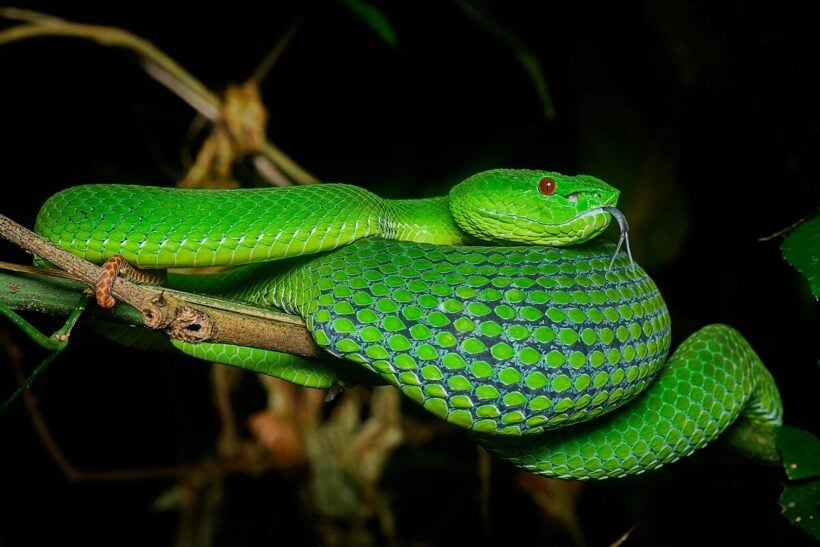What to do if you get bitten by a snake in Thailand

Tropical Thailand is home to over 200 species of snakes, more than 60 of which are considered venomous and a danger to humans. Snakes don’t usually attack unless provoked or threatened, but it doesn’t hurt to be aware of how to deal with a snake bite if you live or are travelling to the Land of Sssmiles. The way a snake bite is handled could mean the difference between life and death.
The chances of crossing paths with a serpent in Thailand are slightly higher in rainy season when some snakes take shelter from the stormy weather by slithering into people’s homes. Snakes like to hide, so it’s a good idea to keep your house free of clutter so you don’t accidentally disturb a cobra curled up in your washing pile.
Make yourself familiar with the characteristics of Thailand’s most venomous and dangerous snakes. If you see one, do not attempt to handle it yourself. Admire its beauty from a safe distance.
Thailand’s most venomous snakes include cobras (monocled cobra, king cobra, siamese spitting cobra), kraits (Malayan krait, banded krait, red-headed krait, and many-banded krait), some species of keelbacks (red-necked keelback, green keelback, speckle-headed keelback, blue-necked keelback), and vipers (Malayan pit viper, Eastern Russell’s viper, white-lipped pit viper, big-eyed pit viper and many more).
Many species look similar. Swelling or change in colour in and around the bite area indicates that the snake was venomous.
If you get bitten by a snake (venomous or not), take the following steps…
- Stay calm. Even if a venomous snake bites you, it might not release venom. If venom does enter the body, it can take 30 minutes for severe symptoms to arise.
- Rinse the bite wound with clean water (if you have some). Do NOT: cut the wound, use electrical items on the wound, put ice on the wound, put herbal medicine on the wound, drink alcohol, or take painkillers containing aspirin.
- Keep still. Minimise movement of the body, especially in the area of the bite wound. For example, if you get bitten on your hand, keep it still. Movement causes more venom to be absorbed and causes the venom to travel around the body.
- Do NOT attempt to suck the venom from the wound. This is a common myth about avoiding fatal snake bites. It is not proven to remove the venom from the body and could increase the damage at the bite site.
- Get to the nearest hospital as soon as possible. If the snake bite victim stops breathing before arriving at the hospital, first aid should be performed on them. Some venomous snakes such as cobras, king cobras, and kraits have venom which paralyses the human body. Deaths that occur as a result of bites from such snakes are usually due to cessation of breathing. To call an ambulance, call Thailand’s emergency ambulance hotline on 1669.
If you get bitten, it is important to try and remember the characteristics of the snake. Doctors prescribe different antivenoms depending on the species of snake, so it is crucial to know what kind of snake it is to get the right treatment.
Snake bite victims may find it hard to remember what the snake looked like due to stress and also because snakes can be quick. You’re more likely to remember if you’re clued up on snakes. There are various snake identification groups on Facebook which are great to follow if you want to familiarise yourself with Thailand’s snakes. The main groups include Snakes of Isaan, Snakes of Bangkok, Snakes of Phuket, and Snakes of Pattaya.
If you’re serious about herpetology, the book ‘A Naturalist’s Guide to the Snakes of Southeast Asia’ by Indraneil Das is an essential purchase. The book teaches how to correctly identify and differentiate species of snakes in Thailand and Southeast Asia.
You’re more likely to come across snakes in rural areas of Thailand. Although, Bangkok is also home to snakes. Yesterday, a Thai woman took to Facebook to complain about how a shopping mall in Bangkok refused to take responsibility after she was bitten by a venomous red-tailed pit viper in the mall’s car park. Her foot was very swollen and most likely painful, but she did survive.
Every year, around 2,500 people die from snake bites in southeast Asia. Globally, around 81,000 – 138,000 people die from snake bites each year, according to the World Health Organisation.
The best way to avoid a trip to the hospital (or worse) is to let snakes do their thing. If you see a snake in Thailand, stay calm and stay away from it. It might bite you if you hiss it off.
SOURCE: Ejan
Latest Thailand News
Follow The Thaiger on Google News:


























